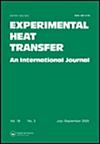Experimental study of heat transfer in a microchannel with pin fins and sintered coatings
IF 2.9
3区 工程技术
Q2 ENGINEERING, MECHANICAL
引用次数: 5
Abstract
ABSTRACT Increasing processing capacity without modifying the size of electronic devices has made thermal management important in the electronic industry. Commercialized thermal management, such as in a conventional air cooling system, is insufficient for electronic devices with high heat flux dissipation. Pool boiling is a better method for heat transfer because it can dissipate a substantial amount of heat at low wall superheats. This study focused on heat transfer enhancement using passive approaches, including nanostructures and microporous sintered surfaces over open microchannel surfaces and microchannels with pin-fins. In the present work, seven structures were studied in pool boiling, wherein experiments elucidated the effects of microchannels, sintered, and pin fins (micropillar) on boiling heat transfer from a copper chip in a pool of degassed water. Boiling performance is ascertained via critical heat flux (CHF) and heat transfer coefficient (HTC). The best heat transfer performance showed a heat flux of 243.75W/cm2 at 15.46°C on the pin-fins chip, which was 1.9 times the heat flux of the plain chip. The highest HTC was 181.03 kW/(m2 oC) at a heat flux of 172.61 W/cm2 for the microchannel with single pin-fins. The HTC enhancement was 2.8 times greater than the plain surface. It was found experimentally that HTC and CHF improved on all modified surfaces compared to the plain copper chip baseline.带针状鳍和烧结涂层的微通道传热实验研究
摘要在不改变电子设备尺寸的情况下提高处理能力,使热管理在电子行业变得重要。商业化的热管理,例如在传统的空气冷却系统中,不足以用于具有高热通量耗散的电子设备。池沸腾是一种更好的传热方法,因为它可以在低壁面过热度下散发大量热量。这项研究的重点是使用被动方法增强传热,包括在开放的微通道表面和带有针鳍的微通道上的纳米结构和微孔烧结表面。在本工作中,在池沸腾中研究了七种结构,其中实验阐明了微通道、烧结和针状翅片(微柱)对脱气水池中铜芯片沸腾传热的影响。沸腾性能是通过临界热通量(CHF)和传热系数(HTC)来确定的。最佳的传热性能显示,在15.46°C下,针鳍芯片的热通量为243.75W/cm2,是普通芯片热通量的1.9倍。最高HTC为181.03 对于具有单针翅片的微通道,在172.61 W/cm2的热通量下为kW/(m2 oC)。HTC的增强是平面的2.8倍。实验发现,与普通铜芯片基线相比,HTC和CHF在所有改性表面上都有所改善。
本文章由计算机程序翻译,如有差异,请以英文原文为准。
求助全文
约1分钟内获得全文
求助全文
来源期刊

Experimental Heat Transfer
工程技术-工程:机械
CiteScore
6.30
自引率
37.10%
发文量
61
审稿时长
>12 weeks
期刊介绍:
Experimental Heat Transfer provides a forum for experimentally based high quality research articles and communications in the general area of heat-mass transfer and the related energy fields.
In addition to the established multifaceted areas of heat transfer and the associated thermal energy conversion, transport, and storage, the journal also communicates contributions from new and emerging areas of research such as micro- and nanoscale science and technology, life sciences and biomedical engineering, manufacturing processes, materials science, and engineering. Heat transfer plays an important role in all of these areas, particularly in the form of innovative experiments and systems for direct measurements and analysis, as well as to verify or complement theoretical models.
All submitted manuscripts are subject to initial appraisal by the Editor, and, if found suitable for further consideration, to peer review by independent, anonymous expert referees. All peer reviews are single blind and submission is online via ScholarOne Manuscripts. Original, normal size articles, as well as technical notes are considered. Review articles require previous communication and approval by the Editor before submission for further consideration.
 求助内容:
求助内容: 应助结果提醒方式:
应助结果提醒方式:


